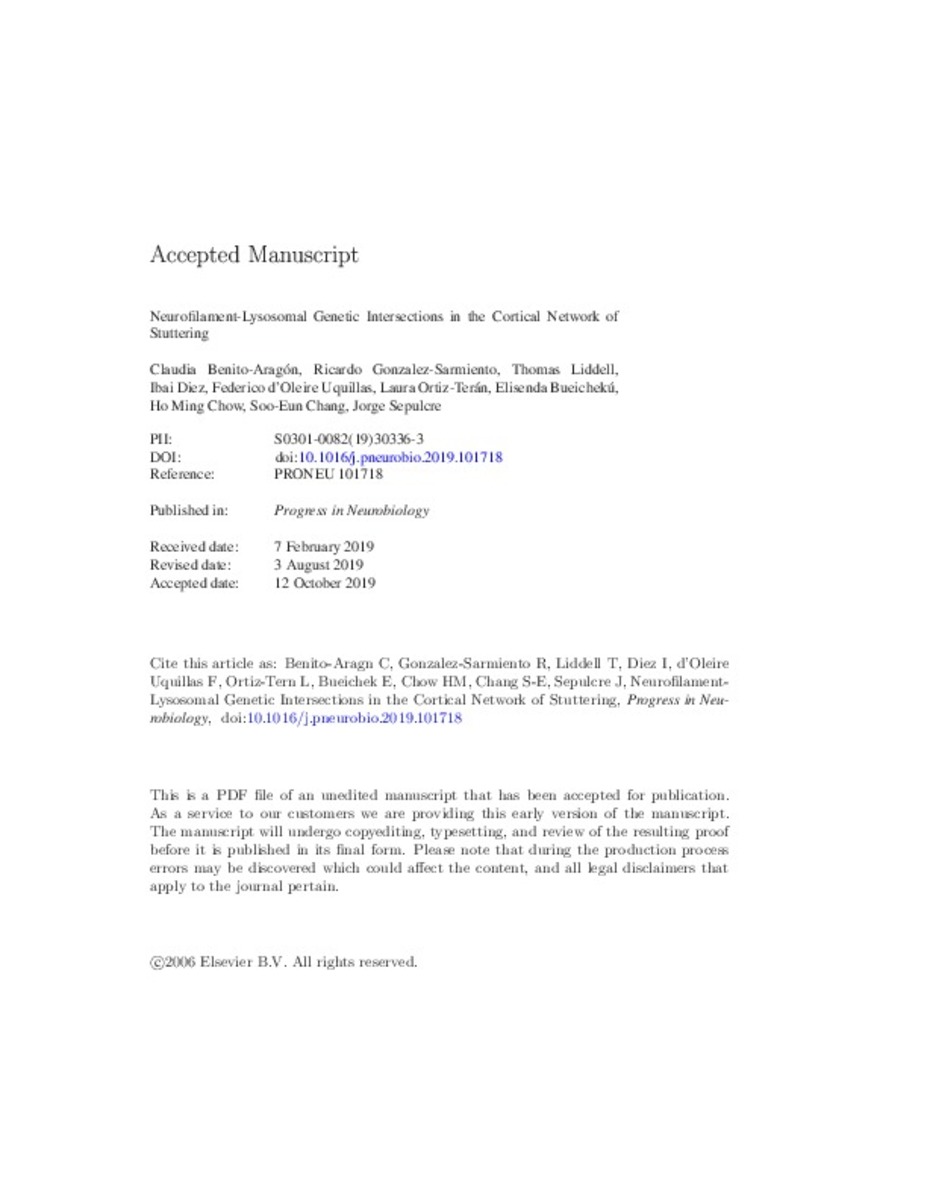Mostrar el registro sencillo del ítem
Neurofilament-lysosomal genetic intersections in the cortical network of stuttering
| dc.contributor.author | Benito-Aragón, Claudia | |
| dc.contributor.author | González-Sarmiento, Ricardo | |
| dc.contributor.author | Liddell, Thomas | |
| dc.contributor.author | Diez, Ibai | |
| dc.contributor.author | d'Oleire Uquillas, Federico | |
| dc.contributor.author | Ortiz-Terán, Laura | |
| dc.contributor.author | Bueichekú, Elisenda | |
| dc.contributor.author | Chow, Ho Ming | |
| dc.contributor.author | Chang, Soo-Eun | |
| dc.contributor.author | Sepulcre, Jorge | |
| dc.date.accessioned | 2020-05-08T08:47:09Z | |
| dc.date.available | 2020-05-08T08:47:09Z | |
| dc.date.issued | 2019-10-24 | |
| dc.identifier.citation | BENITO-ARAGÓN, Claudia, et al. Neurofilament-lysosomal genetic intersections in the cortical network of stuttering. Progress in Neurobiology, 2020, vol. 184, p. 101718. | ca_CA |
| dc.identifier.issn | 0301-0082 | |
| dc.identifier.issn | 1873-5118 | |
| dc.identifier.uri | http://hdl.handle.net/10234/187861 | |
| dc.description.abstract | The neurobiological underpinnings of stuttering, a speech disorder characterized by disrupted speech fluency, remain unclear. While recent developments in the field have afforded researchers the ability to pinpoint several genetic profiles associated with stuttering, how these specific genetic backgrounds impact neuronal circuits and how they generate or facilitate the emergence of stuttered speech remains unknown. In this study, we identified the large-scale cortical network that characterizes stuttering using functional connectivity MRI and graph theory. We performed a spatial similarity analysis that examines whether the topology of the stuttering cortical network intersects with genetic expression levels of previously reported genes for stuttering from the protein-coding transcriptome data of the Allen Human Brain Atlas. We found that GNPTG – a gene involved in the mannose-6-phosphate lysosomal targeting pathways – was significantly co-localized with the stuttering cortical network. An enrichment analysis demonstrated that the genes identified with the stuttering cortical network shared a significantly overrepresented biological functionality of Neurofilament Cytoskeleton Organization (NEFH, NEFL and INA). The relationship between lysosomal pathways, cytoskeleton organization, and stuttering, was investigated by comparing the genetic interactome between GNPTG and the neurofilament genes implicated in the current study. We found that genes of the interactome network, including CDK5, SNCA, and ACTB, act as functional links between lysosomal and neurofilament genes. These findings support the notion that stuttering is due to a lysosomal dysfunction, which has deleterious effects on the neurofilament organization of the speech neuronal circuits. They help to elucidate the intriguing, unsolved link between lysosomal mutations and the presence of stuttering. | ca_CA |
| dc.format.extent | 31 p. | ca_CA |
| dc.format.mimetype | application/pdf | ca_CA |
| dc.language.iso | eng | ca_CA |
| dc.publisher | Elsevier | ca_CA |
| dc.relation.isPartOf | Progress in Neurobiology, Volume 184, January 2020. | ca_CA |
| dc.rights | 0301-0082/ © 2019 Elsevier Ltd. All rights reserved. | ca_CA |
| dc.rights.uri | http://rightsstatements.org/vocab/InC/1.0/ | * |
| dc.subject | Stuttering | ca_CA |
| dc.subject | Genetics | ca_CA |
| dc.subject | Cortical network | ca_CA |
| dc.subject | Lysosomal | ca_CA |
| dc.subject | Neurofilament | ca_CA |
| dc.title | Neurofilament-lysosomal genetic intersections in the cortical network of stuttering | ca_CA |
| dc.type | info:eu-repo/semantics/article | ca_CA |
| dc.identifier.doi | https://doi.org/10.1016/j.pneurobio.2019.101718 | |
| dc.relation.projectID | K23EB019023 (JS), (NIBIB) 2T32EB013180-06 (LOT), R01DC011277 (SC) | ca_CA |
| dc.rights.accessRights | info:eu-repo/semantics/openAccess | ca_CA |
| dc.relation.publisherVersion | https://www.sciencedirect.com/science/article/pii/S0301008219303363 | ca_CA |
| dc.date.embargoEndDate | 2021-04-24 | |
| dc.type.version | info:eu-repo/semantics/acceptedVersion | ca_CA |
Ficheros en el ítem
Este ítem aparece en la(s) siguiente(s) colección(ones)
-
PSB_Articles [1302]
Articles de publicacions periòdiques







